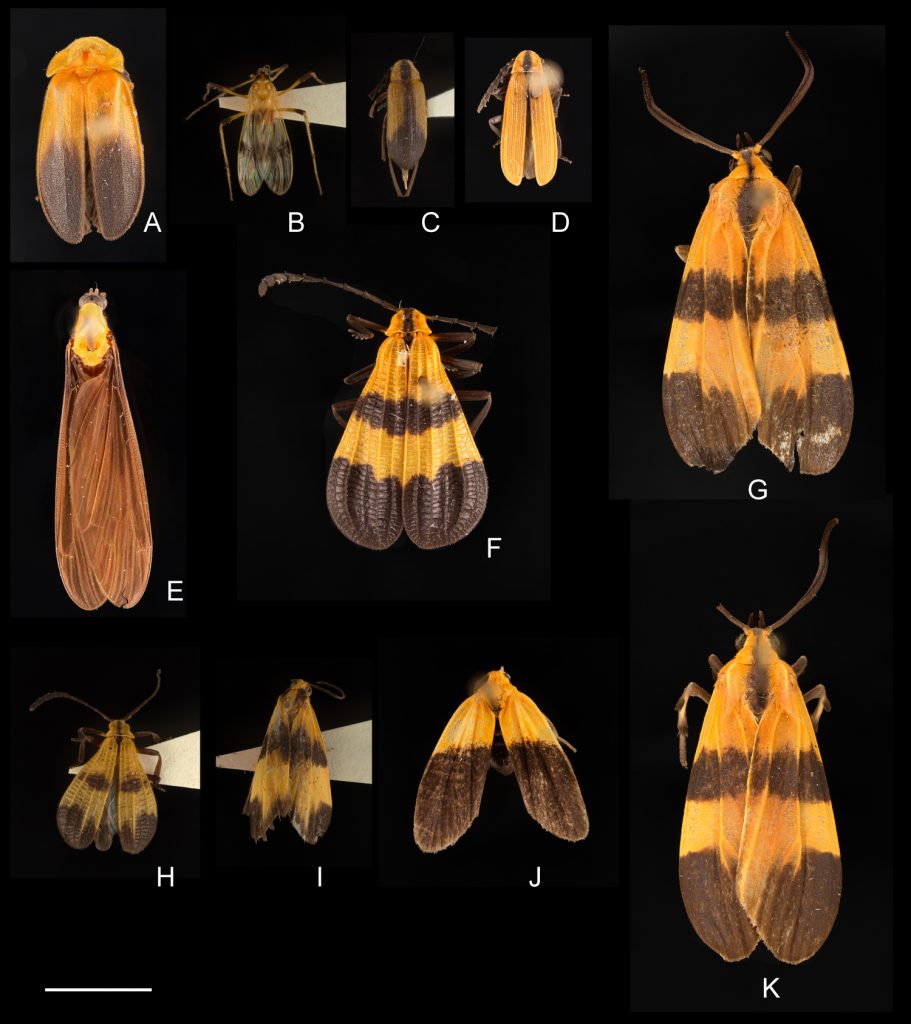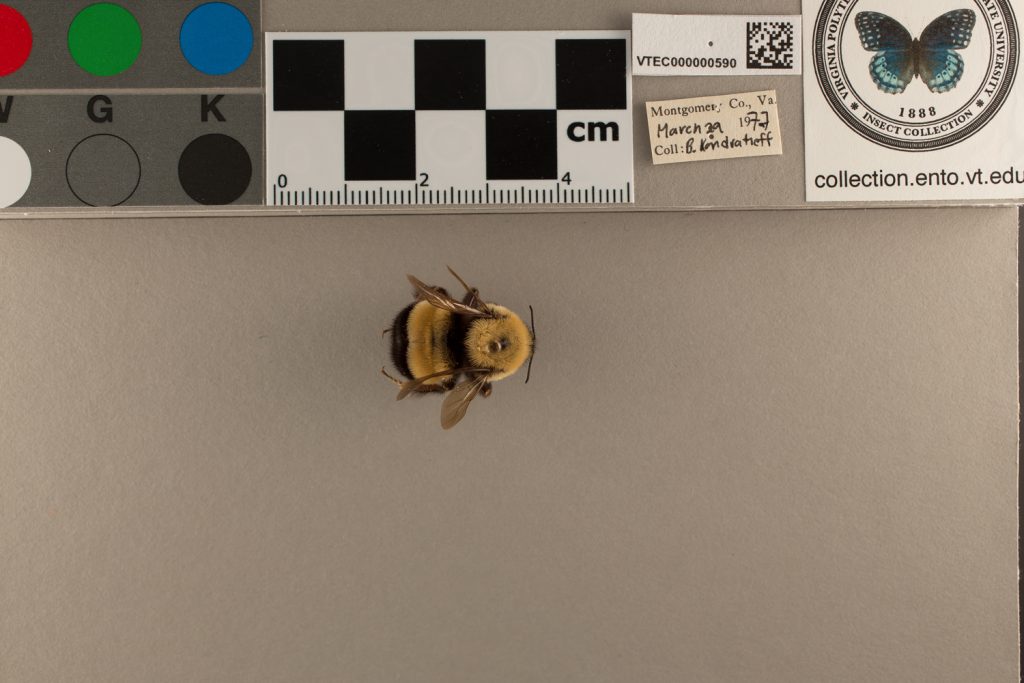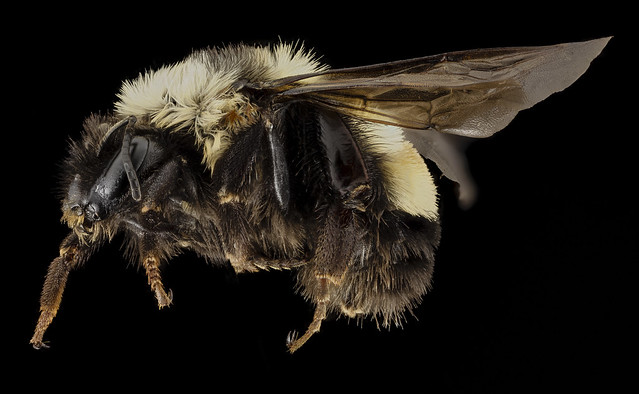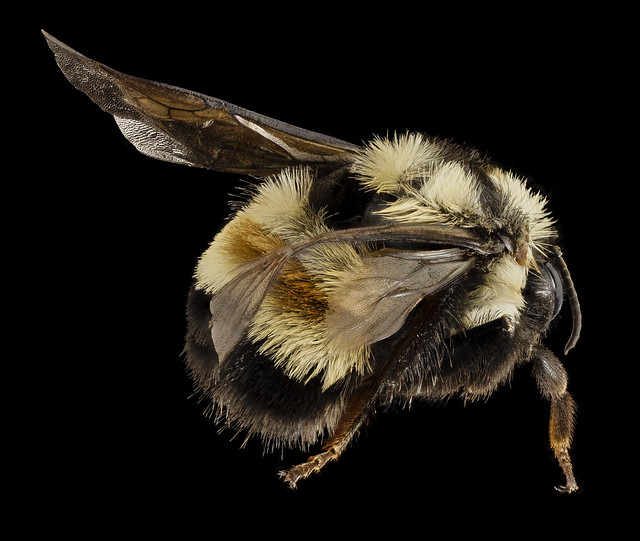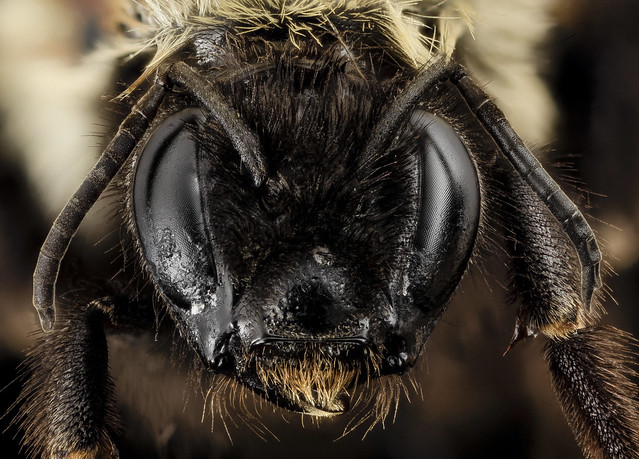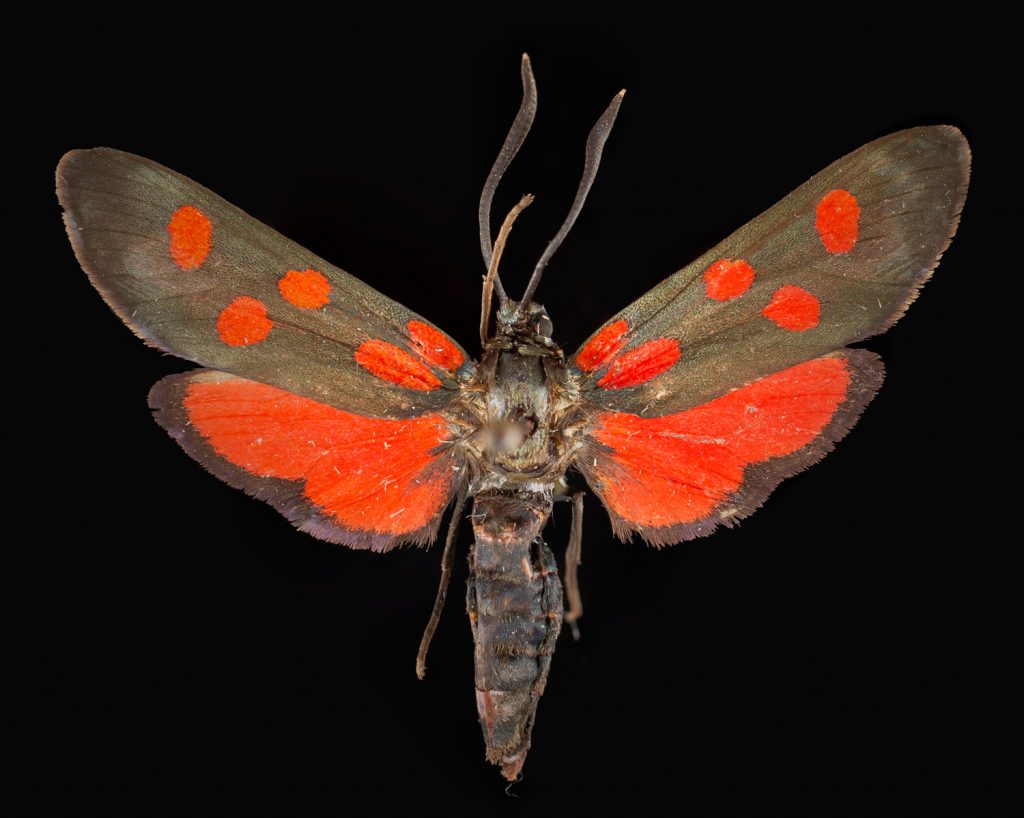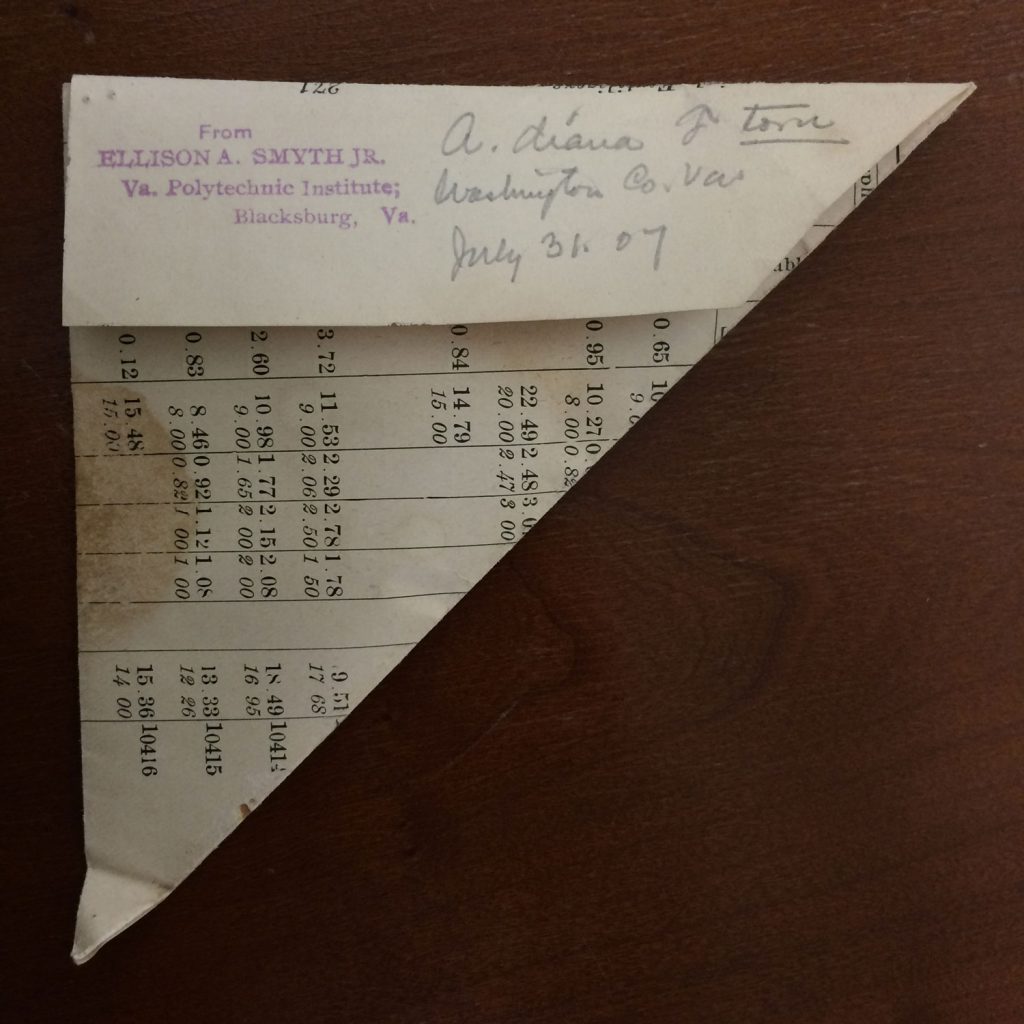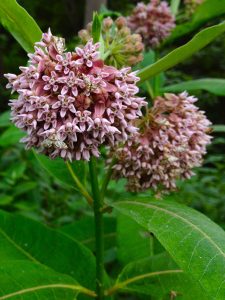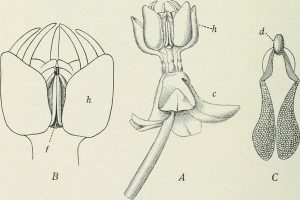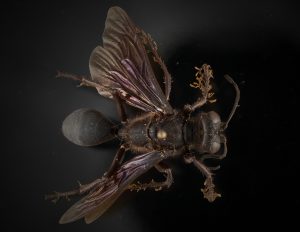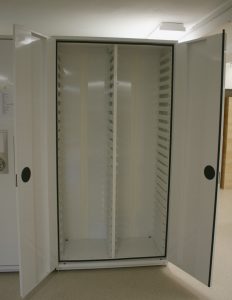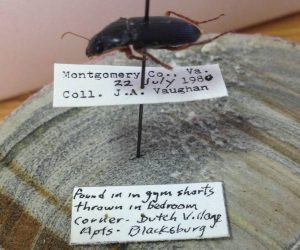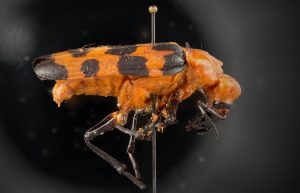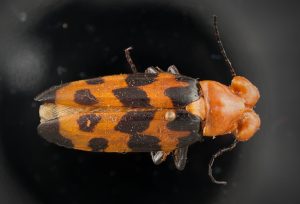
Sweat bee, Augochlora pura mosieri Cockerell, 1922 (family Halictidae)
By Katie Williamson, Derek Hennen, and Paul Marek
What’s one of the first things that comes to your mind when describing a bee? A fuzzy, flying insect? Pollination? Or even how the insect is capable of a rather feisty and painful sting? A member of the order Hymenoptera (“bees, ants, wasps, and hornets”) and the superfamily Apoidea, these mostly-vegetarian bees originated from a lineage of carnivorous, meat-eating wasps such as Cicada Killers, Jewel Wasps, and Mud Daubers. While social bees, such as bumble bees and honey bees, are well known, many species of bees are solitary and do not socialize as much with each other. So what makes a bee a bee? And how diverse are bees? Understanding the evolutionary history of this group can answer these questions.
There are seven families of bees (Andrenidae, Halictidae, Apidae, Mellitidae, Colletidae Megachilidae, and Stenotritidae) and 20,000 known species. Bees are estimated to have first emerged during the Cretaceous Period, and since then, have speciated into tens of thousands of species, each with a morphology that matches their environment. For example, while a Bumble bee (Apidae) may be completely covered with branched hairs, a Sweat bee (Halictidae) possesses minute branched hairs that are nearly impossible to see unless one examines the bee up close. Their branched hairs, a major feature that distinguishes bees, trap pollen grains thereby allowing the bee to gather and transport this protein-rich source of food to their nest. Some bees even have a special built-in pollen basket called a corbicula that they pack with pollen, and still other bees such as the cuckoo bees, have lost pollen collecting structures and evolved to steal other’s pollen.
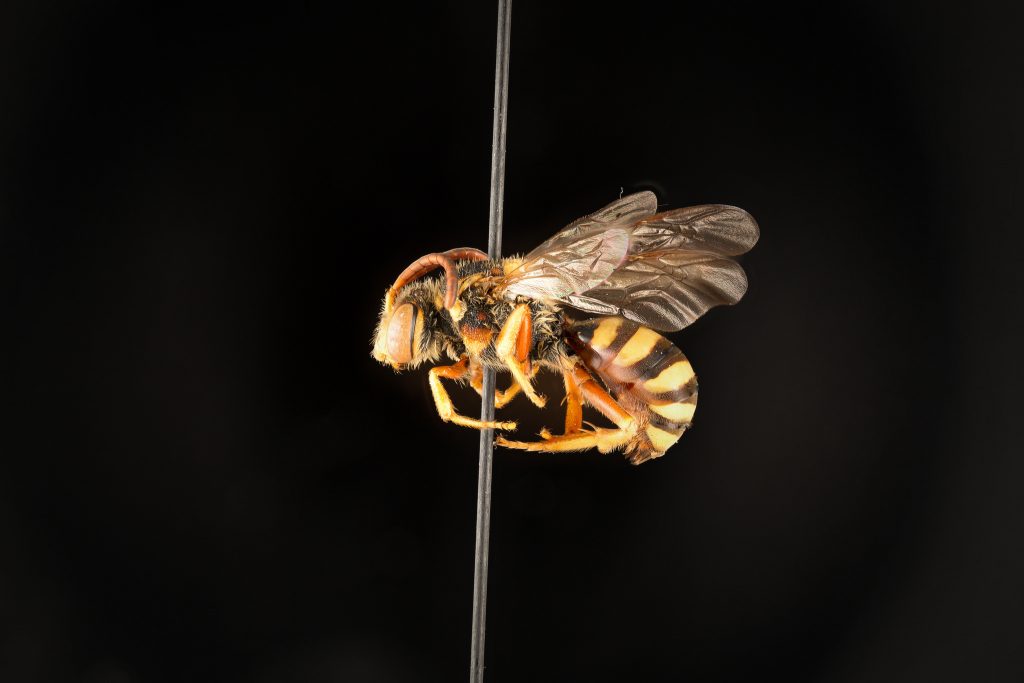
Cuckoo bee, Nomada superba Cresson, 1863 (family Apidae)
Here at the Virginia Tech Insect Collection, we have almost 200 identified species of bees and over 2,000 specimens. We have been collecting bees for over a century, and the oldest specimen in the collection is a Carpenter bee from 1902. Most of the specimens were collected in the United States, particularly Appalachia, and are in the family Apidae, but other bee families are well-represented in our natural history collection. One notable species is the Rusty-patched Bumble bee (Bombus affinis), whose key defining feature is a distinct, orange (rusty) patch of hair on the insect’s abdomen. The specimens in the collection were collected before its recent designation as an endangered species, and can be used in the future by other scientists researching the biology and conservation of the species. Indeed, DNA from specimens preserved in natural history collections have been used to study and mitigate population declines in bees.
All the bee species in the Virginia Tech Insect Collection are listed below, organized by family. Links associated with each species lead to the Symbiota Collections of Arthropods Network, an online database that provides associated collection data and photographs for each bee specimen in the collection. The bees in the VTEC are a result of a century of hard work by entomologists who collected, prepared, and identified specimens in the collection.
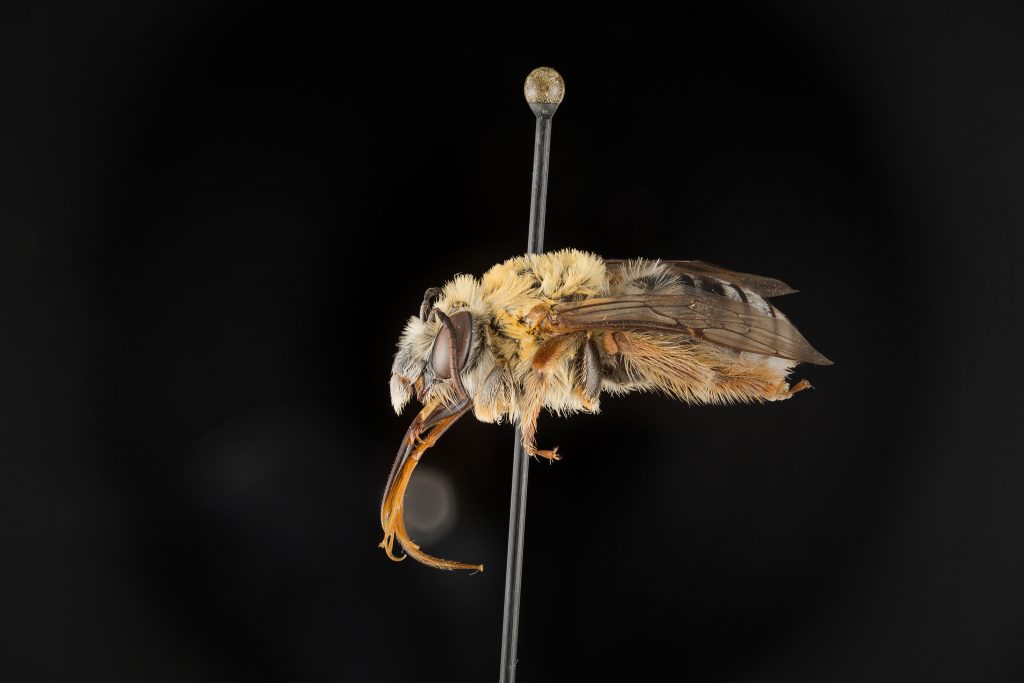
Squash bee, Peponapis pruinosa Say, 1837 (family Apidae)
By studying the bee specimens preserved in the VTEC, researchers are able to answer scientific questions about evolution, morphology, and ecology. Indeed, bees in our collection even retain the pollen that they gathered from the last flower they visited. Palynologists (scientists who study pollen) are able to identify plants from looking at the pollen stuck to the bee. These studies further enhance not only our understanding of bees, but what factors affect their behavior, evolution, and ecological contributions of these amazing animals.
ANDRENIDAE, the Mining bees
Andrena accepta Viereck, 1916
Andrena aliciae Robertson, 1891
Andrena alleghaniensis Viereck, 1907, “Alleghany Andrena”
Andrena barbara Bouseman & LaBerge, 1979, “Barbara’s Miner”
Andrena bisalicis Viereck, 1908
Andrena brevipalpis Cockerell, 1930
Andrena carlini Cockerell, 1901, “Carlin’s Miner”
Andrena carolina Viereck, 1909
Andrena commoda Smith, 1879, “Advantaged Miner Bee”
Andrena confederata Viereck, 1917, “Southern Miner”
Andrena cornelli Viereck, 1907, “Azalea Miner”
Andrena crataegi Robertson, 1893, “Hawthorn Andrena”
Andrena cressonii Robertson, 1891, “Cresson’s Andrena”
Andrena dunningi Cockerell, 1898, “Dunning’s Miner”
Andrena erigeniae Robertson, 1891, “Spring Beauty Andrena”
Andrena fenningeri Viereck, 1922
Andrena forbesii Robertson, 1891, “Forbe’s Andrena”
Andrena heraclei Robertson, 1897
Andrena hippotes Robertson, 1895
Andrena illini Bouseman & LaBerge, 1979
Andrena imitatrix Cresson, 1872
Andrena mariae Robertson, 1891
Andrena miserabilis Cresson, 1872, “Miserable Andrena”
Andrena nasonii Robertson, 1895, “Nason’s Andrena”
Andrena perplexa Smith, 1853
Andrena personata Robertson, 1897
Andrena pruni Robertson, 1891, “Cherry Miner”
Andrena rugosa Robertson, 1891, “Rugose Andrena”
Andrena sayi Robertson, 1891
Andrena spiraeana Robertson, 1895
Andrena tridens Robertson, 1902
Andrena vicina Smith, 1853, “Neighborly Miner”
Andrena violae Robertson, 1891, “Violet Miner”
Andrena wilkella (Kirby, 1802), “Wilke’s Mining Bee”
Calliopsis andreniformis Smith, 1853
Pseudopanurgus Cockerell, 1897
HALICTIDAE, the Sweat bees
Agapostemon radiatus (Say, 1837)
Agapostemon sericeus (Förster, 1771), “Silky Striped-Sweat Bee”
Agapostemon splendens (Lepeletier, 1841), “Brown-Winged Striped-Sweat Bee”
Agapostemon texanus Cresson, 1872, “Texas Striped-Sweat Bee”
Agapostemon virescens (Fabricius, 1775), “Bicolored Striped-Sweat Bee”
Augochlora pura (Say, 1837), “Pure Green Augochlora”
Augochlora pura mosieri Cockerell, 1922
Augochlora pura pura (Say, 1837)
Augochlorella aurata (Smith, 1853)
Augochlorella gratiosa (Smith, 1853)
Augochlorella persimilis (Viereck, 1910)
Augochlorella striata (Provancher, 1888)
Augochloropsis metallica (Fabricius, 1793)
Augochloropsis metallica metallica (Fabricius, 1793)
Augochloropsis sumptuosa (Smith, 1853)
Dialictus Robertson, 1902
Halictus confusus Smith, 1853, “Confusing Metallic-Furrow Bee”
Halictus ligatus Say, 1837, “Ligated Furrow Bee”
Halictus parallelus Say, 1837, “Parallel Furrow Bee”
Halictus rubicundus (Christ, 1791), “Orange-Legged Furrow Bee”
Lasioglossum anomalum (Robertson, 1892), “Anomalous Metallic-Sweat Bee”
Lasioglossum apocyni (Mitchell, 1960)
Lasioglossum arcanus (Sandhouse, 1924)
Lasioglossum bruneri (Crawford, 1902), “Bruner’s Dialictus”
Lasioglossum callidum (Sandhouse, 1924)
Lasioglossum coeruleum (Robertson, 1893)
Lasioglossum coreopsis (Robertson, 1902)
Lasioglossum coriaceum (Smith, 1853)
Lasioglossum cressonii (Robertson, 1890) “Cresson’s Dialictus”
Lasioglossum forbesii (Robertson, 1890)
Lasioglossum foxii (Robertson, 1895)
Lasioglossum fuscipenne (Smith, 1853)
Lasioglossum illinoense (Robertson, 1892)
Lasioglossum imitatum (Smith, 1853)
Lasioglossum leucozonium (Schrank, 1781)
Lasioglossum lineatulum (Crawford, 1906), “Lineated Metallic-Sweat Bee”
Lasioglossum lustrans (Cockerell, 1897)
Lasioglossum macoupinense (Robertson, 1895)
Lasioglossum nelumbonis (Robertson, 1890)
Lasioglossum obscurum (Robertson, 1892)
Lasioglossum pectorale (Smith, 1853)
Lasioglossum pilosum (Smith, 1853)
Lasioglossum platyparium (Robertson, 1895)
Lasioglossum pruinosum (Robertson, 1892), “Pruinose Metallic-Sweat Bee”
Lasioglossum quebecense (Crawford, 1907)
Lasioglossum sopinci (Crawford, 1932)
Lasioglossum tegulare (Robertson, 1890), “Epaulette Metallic-Sweat Bee”
Lasioglossum truncatum (Robertson, 1901)
Lasioglossum versans (Lovell, 1905)
Lasioglossum versatum (Robertson, 1902)
Lasioglossum viridatum (Lovell, 1905)
Lasioglossum zephyrum (Smith, 1853), “Zephyr Dialictus”
Sphecodes banksii Lovell, 1909
Sphecodes heraclei Robertson, 1897
Sphecodes ranunculi Robertson, 1897
COLLETIDAE, the Masked or Plasterer bees
Colletes americanus Cresson, 1868
Colletes compactus Cresson, 1868, “Aster Cellophane Bee”
Colletes eulophi Robertson, 1891
Colletes inaequalis Say, 1837, “Unequal Cellophane Bee”
Colletes latitarsis Robertson, 1891, “Broad-footed Cellophane Bee”
Colletes thoracicus Smith, 1853, “Rufous-Chested Cellophane Bee”
Hylaeus affinis (Smith, 1853), “Eastern Masked Bee”
Hylaeus mesillae (Cockerell, 1896), “Mesilla Masked Bee”
Hylaeus modestus Say, 1837, “Modest Masked Bee”
MEGACHILIDAE, the Leafcutter or Mason bees
Anthidiellum Cockerell, 1904, “Rotund Resin Bees”
Anthidium maculifrons Smith, 1854, “Spot-Fronted Wool-Carder Bee”
Anthidium manicatum (Linnaeus, 1758), “European Woolcarder”
Anthidium oblongatum (Illiger, 1806), “Oblong Woolcarder”
Coelioxys moesta Cresson, 1864
Coelioxys octodentata Say, 1824, “Eight-toothed Cuckoo-leaf-cutter”
Coelioxys rufitarsis Smith, 1854, “Red-footed Cuckoo-leaf-cutter”
Coelioxys sayi Robertson, 1897, “Say’s Cuckoo-leaf-cutter”
Coelioxys slossoni Viereck, 1902
Heriades carinatus Cresson, 1864
Heriades variolosus (Cresson, 1872)
Hoplitis pilosifrons (Cresson, 1864)
Hoplitis producta (Cresson, 1864)
Hoplitis spoliata (Provancher, 1888)
Lithurgus Berthold, 1827
Megachile brevis Say, 1837, “Common Little Leaf-cutter Bee”
Megachile campanulae (Robertson, 1903), “Bellflower Resin Bee”
Megachile frigida Smith, 1853, “Frigid Leafcutter”
Megachile gemula Cresson, 1878, “Small-handed Leaf-cutter Bee”
Megachile inimica sayi Cresson, 1878, “Hostile Leaf-cutter Bee”
Megachile latimanus Say, 1823, “Broad-handed Leafcutter Bee”
Megachile mendica Cresson, 1878, “Flat-tailed Leaf-cutter Bee”
Megachile onobrychidis Cockerell, 1908, “Western Little Leaf-cutter Bee”
Megachile perihirta Cockerell, 1898, “Western Leafcutter Bee”
Megachile petulans Cresson, 1878, “Petulant Leaf-cutter Bee”
Megachile pugnata Say, 1837, “Pugnacious Leaf-cutter Bee”
Megachile relativa Cresson, 1878, “Golden-tailed Leafcutter Bee”
Megachile rotundata (Fabricius, 1793), “Alfalfa Leafcutter Bee”
Megachile texana Cresson, 1878, “Texas Leaf-cutter Bee”
Megachile townsendiana Cockerell, 1898
Osmia albiventris Cresson, 1864
Osmia atriventris Cresson, 1864, “Blueberry Bee”
Osmia bucephala Cresson, 1864, “Bufflehead Mason Bee”
Osmia conjuncta Cresson, 1864
Osmia cornifrons (Radoszkowski, 1887), “Horned-face Bee”
Osmia georgica Cresson, 1878
Osmia lignaria Say, 1837, “Blue Orchard Mason Bee”
Osmia lignaria lignaria Say, 1837
Osmia pumila Cresson, 1864
Osmia subfasciata Cresson, 1872
Osmia taurus Smith, 1873, “Taurus Mason Bee”
Osmia texana Cresson, 1872, “Texas Osmia”
Osmia virga Sandhouse, 1939
Paranthidium jugatorium (Say, 1824)
Stelis lateralis Cresson, 1864
APIDAE, the Cuckoo, Carpenter, Digger, Bumble, and Honey Bees
Anthedonia compta (Cresson, 1878)
Anthophora abrupta Say, 1837, “Abrupt Digger Bee”
Anthophora bomboides Kirby, 1837, “Bumble-bee Digger”
Anthophora bomboides bomboides Kirby 1837
Anthophora pacifica Cresson, 1878, “Pacific Digger”
Anthophora terminalis Cresson, 1869, “Orange-tipped Wood-digger”
Anthophora urbana Cresson, 1878, “Urbane Digger”
Anthophora ursina Cresson, 1869, “Ursine Digger”
Apis mellifera Linnaeus, 1758, “European honey bee”
Bombus affinis Cresson, 1863, “Rusty patched bumble bee”
Bombus ashtoni (Cresson, 1864), “Ashton’s Cuckoo Bumblebee”
Bombus auricomus (Robertson, 1903), “Black-and-gold Bumble Bee”
Bombus bimaculatus Cresson, 1863, “Two-spotted Bumble Bee”
Bombus borealis Kirby, 1837, “Northern Amber Bumble Bee”
Bombus citrinus (Smith, 1854), “Lemon Cuckoo Bumble Bee”
Bombus fernaldae (Franklin, 1911), “Fernald’s Cuckoo Bumble Bee”
Bombus fervidus (Fabricius, 1798), “Golden Northern Bumble Bee”
Bombus griseocollis (DeGeer, 1773), “Brown-belted Bumble Bee”
Bombus impatiens Cresson, 1863, “Common Eastern Bumble Bee”
Bombus nevadensis Cresson, 1874, “Nevada Bumble Bee”
Bombus pensylvanicus (De Geer, 1773), “American Bumble Bee”
Bombus perplexus Cresson, 1863, “Perplexing Bumble Bee”
Bombus sandersoni Franklin, 1913, “Sanderson’s Bumble Bee”
Bombus vagans Smith, 1854, “Half-black Bumble Bee”
Bombus variabilis (Cresson, 1872), “Variable Cuckoo Bumble Bee”
Bombus vosnesenskii Radoszkowski, 1862, “Yellow-faced Bumble Bee”
Ceratina calcarata Robertson, 1900, “Spurred Ceratina”
Ceratina dupla Say, 1837, “Doubled Ceratina”
Ceratina strenua Smith, 1879, “Nimble Ceratina”
Eulaema Lepeletier, 1841
Habropoda laboriosa (Fabricius, 1804), “Blueberry Digger”
Holcopasites calliopsidis (Linsley, 1943)
Melissodes agilis Cresson, 1878, “Agile Long-horned Bee”
Melissodes bidentis Cockerell, 1914
Melissodes bimaculata (Lepeletier, 1825), “Two-spotted Longhorn”
Melissodes bimaculata bimaculata (Lepeletier, 1825)
Melissodes communis Cresson, 1878, “Common Long-horned Bee”
Melissodes denticulata Smith, 1854
Melissodes fimbriata Cresson, 1878
Melissodes rustica (Say, 1837)
Melissodes trinodis Robertson, 1901
Melitoma taurea (Say, 1837), “Chimney Bee”
Nomada articulata Smith, 1854
Nomada composita Mitchell, 1962
Nomada imbricata Smith, 1854
Nomada luteoloides Robertson, 1895
Nomada maculata Cresson, 1863, “Spotted Nomad Bee”
Nomada superba Cresson, 1863, “Superb Nomada”
Nomada vegana Cockerell, 1903
Peponapis pruinosa (Say, 1837), “Pruinose Squash Bee”
Psithyrus Lepeletier, 1833, “Cuckoo Bumble Bees”
Ptilothrix bombiformis (Cresson, 1878), “Hibiscus Bee”
Svastra obliqua (Say, 1837), “Sunflower Bee”
Tetralonia Spinola, 1839
Triepeolus lunatus (Say, 1824), “Cuckoo Bee”
Triepeolus remigatus (Fabricius, 1804)
Triepeolus simplex Robertson, 1903
Xenoglossa strenua (Cresson, 1878), “Large Squash Bee”
Xylocopa tabaniformis Smith, 1854, “Horsefly-like Carpenter Bee”
Xylocopa virginica (Linnaeus, 1771), Eastern Carpenter Bee”
Further reading about native bee diversity in the eastern United States
Appalachian Beekeeping Collective
Bees of Blandy Experimental Farm, Virginia
Center for Biological Diversity, Native Bee Diversity
Couvillon Bee Lab at Virginia Tech
Discover Life’s Bee Identification
James Wilson, Extension Apiculturist at Virginia Tech
Native Bee Inventory and Monitoring Lab
Native Bees, Jha Lab, University of Texas at Austin
New York Times, Plan Bee: The Rise of Alternative Pollinators
O’Rourke Lab at Virginia Tech
University of Minnesota, Bee Lab

